TT-INFRA SENSOR
Model: SA2500
- TT-Infra monitors temperature without direct contact. It is generally used between .2”-1” (5-25 mm) from the surface to being measured.
- Accuracy is +/-0.2 degrees C. Can also be used in combination with either the MyoScan or MyoScan-Pro sensor, which snaps to its back.
Product Overview
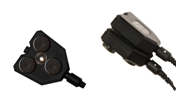 The TT-Infra is a sensitive infrared temperature sensor designed for assessment of temperature variations over the skin.
Scan both Temperature and SEMG Simultaneously by simply snapping a MyoScan SEMG sensor to the back of the TT-Infra sensor. Scan in half the time - or watch changes in both measures in real time.
The TT-Infra is a sensitive infrared temperature sensor designed for assessment of temperature variations over the skin.
Scan both Temperature and SEMG Simultaneously by simply snapping a MyoScan SEMG sensor to the back of the TT-Infra sensor. Scan in half the time - or watch changes in both measures in real time.
Sensor Placement
Temperature Control
The temperature of the examining room must be stable. The room must be draft-free, the doors and windows must be closed. Keep the instrumentation and the examinee away from heat, air conditioning and direct exposure to sunlight.
Preparing the instrumentation
Affix the electrodes on the two TT-Infra sensors, as shown:
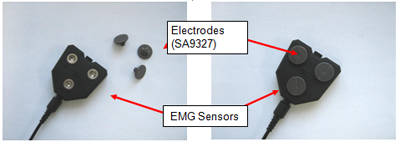
Snap each MyoScan sensor (EMG) on top of the corresponding TT-Infra sensor, as shown:
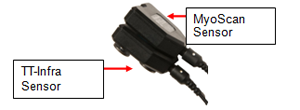

- Put conductive electrode paste or cream on the EMG electrodes (grey area only).
- Place the sensors on the examinee (on their back, for instance, as shown in the next photograph). Position your hands so that the electrodes remain stable and do not move. Apply gentle pressure on the sensor so that the 3 electrodes make good contact with the skin.
Technical Specifications
- Size (approx.) : 368mm x 391mm x 145mm (1.45” x 1.54” x 0.57”)
- Weight : 12.5g (0.44oz)
- Temperature range : 19.80°C – 40.21°C (67.64°F – 104.38°F)
- Absolute accuracy : ±0.5°C (±0.9°F)
- Ambient operating temperature (for paired relative accuracy) : 21°C – 25°C (69.80°F - 77°F)
- Paired relative accuracy : ±0.25°C (±0.45°F)
- Measurement resolution : 0.02°C (±0.036°F)
Interfacing with 3rd Party Data Acquisition Systems
Recommended Connectivity for Electrical Safety
Thought Technology recommends the use of TT Sensor Isolator ST9405AM when interfacing patient connected sensor(s) to line powered equipment(s) or devices.
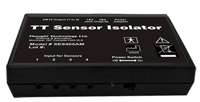 The TT Sensor Isolator ST9405AM is an interface device providing medical grade electrical isolation between the patient connected sensors and the acquisition system. It provides the equivalent of Two Means of Patient Protection under IEC 60601-1, and supplies battery power to the sensors. Using this device ensures Thought Technology sensors are safely interfaced to the analog inputs of line-powered systems such as computers with DAQ cards.
The TT Sensor Isolator ST9405AM is an interface device providing medical grade electrical isolation between the patient connected sensors and the acquisition system. It provides the equivalent of Two Means of Patient Protection under IEC 60601-1, and supplies battery power to the sensors. Using this device ensures Thought Technology sensors are safely interfaced to the analog inputs of line-powered systems such as computers with DAQ cards.
Note that this device isolates only between sensors and the DAQ interface, not between different sensor channels.
The TT Sensor Isolator can interface up to 4 sensors to a DAQ card. TT Sensor Isolator can be connected to the DAQ card in two ways:
- via two stereo jacks, or
- via a DB-15 connector; a BNC interface cable (SA9409BNC) or a pigtail cable (SA9409PGT) can be provided with the unit.

For more detailed information on the Sensor Isolator 4∞, consult the Thought Technology Science Division website or contact the sales department or your distributor.
Division website or contact the sales department or your distributor.
Direct Connectivity for Electrically Isolated Systems
The following notes are provided for qualified users to directly interface Thought Technology sensors with external systems.
WARNING: If the sensor is interfaced to non-Thought Technology devices without the use of a TT Sensor Isolator SE9405AM, an elevated risk of electrical shock may be present. In particular, if a patient-connected sensor is connected to any line powered device(s) or equipment(s), it will be the responsibility of the qualified user to ensure the electrical safety in the setup and to ensure that the device or equipment provides sufficient isolation.
To interface with a sensor, a single sensor cable may be cut in half. Both sides can then be used to make custom interfacing cables by stripping the outer insulation of each required conductor. The sensor cable contains 4 color coded conductors. The table below shows the color coding and pin connector assignment.
| Pin | Color Code | Function | Note |
| 1 | metal (shield) | ground | Signal and power ground, connection required. |
| 2 | yellow | auxiliary (sensor ID) | No connection required. |
| 3 | green | signal | Sensor output signal |
| 4 | red | sensor power | Supply voltage, +7.26V referenced to ground. Note: sensor performance may be sensitive to supply voltage. |

Notes:
1. The nominal supply voltage for this sensor is 7.26V. The sensor can safely be used with a supply voltage of up to 9V.
Recommended Specifications for DAQ Hardware
- Recommended resolution of 0.15mV (16-bit ADC over 10V span) or better
- Minimum input range:
- If connected via SE9405AM Sensor Isolator, choose 0-5V (unipolar) or ±5V (bipolar).
- If directly connected to DAQ, choose ±5V (bipolar).
Simplified Transfer Function
![]() Temperature in Celsius to output voltage in volts.
Temperature in Celsius to output voltage in volts.
![]() Voltage [V] conversion to temperature [ºC].
Voltage [V] conversion to temperature [ºC].
![]() Voltage [V] conversion to temperature [ºF].
Voltage [V] conversion to temperature [ºF].
Product Overview
 The TT-Infra is a sensitive infrared temperature sensor designed for assessment of temperature variations over the skin.
Scan both Temperature and SEMG Simultaneously by simply snapping a MyoScan SEMG sensor to the back of the TT-Infra sensor. Scan in half the time - or watch changes in both measures in real time.
The TT-Infra is a sensitive infrared temperature sensor designed for assessment of temperature variations over the skin.
Scan both Temperature and SEMG Simultaneously by simply snapping a MyoScan SEMG sensor to the back of the TT-Infra sensor. Scan in half the time - or watch changes in both measures in real time.
Sensor Placement
Temperature Control
The temperature of the examining room must be stable. The room must be draft-free, the doors and windows must be closed. Keep the instrumentation and the examinee away from heat, air conditioning and direct exposure to sunlight.
Preparing the instrumentation
Affix the electrodes on the two TT-Infra sensors, as shown:

Snap each MyoScan sensor (EMG) on top of the corresponding TT-Infra sensor, as shown:


- Put conductive electrode paste or cream on the EMG electrodes (grey area only).
- Place the sensors on the examinee (on their back, for instance, as shown in the next photograph). Position your hands so that the electrodes remain stable and do not move. Apply gentle pressure on the sensor so that the 3 electrodes make good contact with the skin.
Technical Specifications
- Size (approx.) : 368mm x 391mm x 145mm (1.45” x 1.54” x 0.57”)
- Weight : 12.5g (0.44oz)
- Temperature range : 19.80°C – 40.21°C (67.64°F – 104.38°F)
- Absolute accuracy : ±0.5°C (±0.9°F)
- Ambient operating temperature (for paired relative accuracy) : 21°C – 25°C (69.80°F - 77°F)
- Paired relative accuracy : ±0.25°C (±0.45°F)
- Measurement resolution : 0.02°C (±0.036°F)
Interfacing with 3rd Party Data Acquisition Systems
Recommended Connectivity for Electrical Safety
Thought Technology recommends the use of TT Sensor Isolator ST9405AM when interfacing patient connected sensor(s) to line powered equipment(s) or devices.
 The TT Sensor Isolator ST9405AM is an interface device providing medical grade electrical isolation between the patient connected sensors and the acquisition system. It provides the equivalent of Two Means of Patient Protection under IEC 60601-1, and supplies battery power to the sensors. Using this device ensures Thought Technology sensors are safely interfaced to the analog inputs of line-powered systems such as computers with DAQ cards.
The TT Sensor Isolator ST9405AM is an interface device providing medical grade electrical isolation between the patient connected sensors and the acquisition system. It provides the equivalent of Two Means of Patient Protection under IEC 60601-1, and supplies battery power to the sensors. Using this device ensures Thought Technology sensors are safely interfaced to the analog inputs of line-powered systems such as computers with DAQ cards.
Note that this device isolates only between sensors and the DAQ interface, not between different sensor channels.
The TT Sensor Isolator can interface up to 4 sensors to a DAQ card. TT Sensor Isolator can be connected to the DAQ card in two ways:
- via two stereo jacks, or
- via a DB-15 connector; a BNC interface cable (SA9409BNC) or a pigtail cable (SA9409PGT) can be provided with the unit.

For more detailed information on the Sensor Isolator 4∞, consult the Thought Technology Science Division website or contact the sales department or your distributor.
Division website or contact the sales department or your distributor.
Direct Connectivity for Electrically Isolated Systems
The following notes are provided for qualified users to directly interface Thought Technology sensors with external systems.
WARNING: If the sensor is interfaced to non-Thought Technology devices without the use of a TT Sensor Isolator SE9405AM, an elevated risk of electrical shock may be present. In particular, if a patient-connected sensor is connected to any line powered device(s) or equipment(s), it will be the responsibility of the qualified user to ensure the electrical safety in the setup and to ensure that the device or equipment provides sufficient isolation.
To interface with a sensor, a single sensor cable may be cut in half. Both sides can then be used to make custom interfacing cables by stripping the outer insulation of each required conductor. The sensor cable contains 4 color coded conductors. The table below shows the color coding and pin connector assignment.
| Pin | Color Code | Function | Note |
| 1 | metal (shield) | ground | Signal and power ground, connection required. |
| 2 | yellow | auxiliary (sensor ID) | No connection required. |
| 3 | green | signal | Sensor output signal |
| 4 | red | sensor power | Supply voltage, +7.26V referenced to ground. Note: sensor performance may be sensitive to supply voltage. |

Notes:
1. The nominal supply voltage for this sensor is 7.26V. The sensor can safely be used with a supply voltage of up to 9V.
Recommended Specifications for DAQ Hardware
- Recommended resolution of 0.15mV (16-bit ADC over 10V span) or better
- Minimum input range:
- If connected via SE9405AM Sensor Isolator, choose 0-5V (unipolar) or ±5V (bipolar).
- If directly connected to DAQ, choose ±5V (bipolar).
Simplified Transfer Function
![]() Temperature in Celsius to output voltage in volts.
Temperature in Celsius to output voltage in volts.
![]() Voltage [V] conversion to temperature [ºC].
Voltage [V] conversion to temperature [ºC].
![]() Voltage [V] conversion to temperature [ºF].
Voltage [V] conversion to temperature [ºF].
Technical Specifications
| Size (approx.) :368mm x 391mm x 145mm (1.45” x 1.54” x 0.57”) |
| Weight :12.5g (0.44oz) |
| Temperature range :19.80°C – 40.21°C (67.64°F – 104.38°F) |
| Absolute accuracy :±0.5°C (±0.9°F) |
| Ambient operating temperature (for paired relative accuracy) :21°C – 25°C (69.80°F - 77°F) |
| Paired relative accuracy :±0.25°C (±0.45°F) |
| Measurement resolution :0.02°C (±0.036°F) |
More Products to Consider
Table of Contents
Suggested References
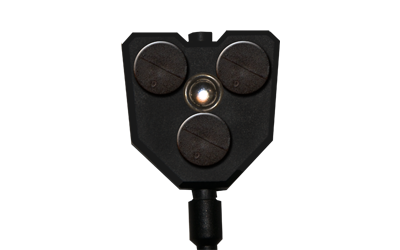
 TT Infra Sensor
TT Infra Sensor